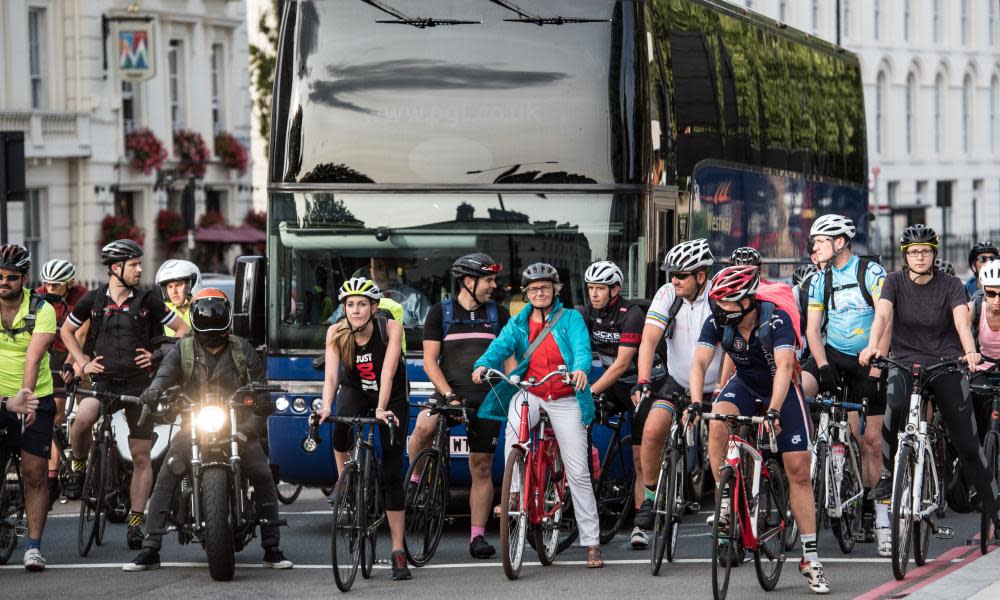Killer cyclists? Let’s not forget the real threat on our roads

Last weekend, as rumours of a “death by dangerous cycling” law circulated, I went on TV to defend cyclists again. Above a banner that read “killer cyclists”, I tried to explain that although there’s nothing wrong with bridging a gap in the law by creating a new offence – if our goal is to improve road safety – in seeking to penalise cyclists we are going after the wrong villain.
The new law was mooted, along with a cycle safety review, following the Charlie Alliston case last year. Alliston was jailed for 18 months for “wanton and furious driving”, after he collided with pedestrian Kim Briggs while riding a bicycle with no front brakes. Briggs died of head injuries.
New offence or no, my point is about our attitude to road safety more broadly. While Alliston clearly was at fault, not all cyclist-pedestrian collisions are the fault of the cyclist. People do sometimes step out without looking, leaving a cyclist, or indeed a driver, too little time to brake. People on bikes do stupid, infuriating things. But they are not the vehicles of mass carnage that they are sometimes presented as.
Of around 400 pedestrians killed in collisions in the UK each year, about 2.5 involve a bicycle. Put it another way: more than 99% of pedestrian collision deaths in this country involve a motorised vehicle. In 2016, road traffic collisions reached a five-year high of 1,792 deaths, with the greatest increase (10%) among pedestrians. Vulnerable pedestrians – generally older people and children – fared particularly badly.
Simply put, a 1,000kg car moving at 22mph will exert a force of 50kJ; a 15kg bike with a 70kg rider at the same speed exerts less than one-tenth of that. Commuter cyclists tend to ride a lot slower, though, while most drivers travel faster. The likelihood of killing someone is far greater when driving a car than riding a bike.
Because cars dominate our streets, we are blind to just how dangerous they can be
Yet I would argue that, because cars dominate our streets, we are blind to just how dangerous they can be. Jumping red lights is just one of the cycling misdemeanours I am regularly called upon to defend, when a freedom of information request by Cycling UK showed that about 95% of light-jumping vehicles that hit pedestrians are motorised.
This imbalance is reflected in the press. While the Alliston case saw enormous media coverage, few – if any – fatal pedestrian collisions with motor vehicles are talked about at such length.
It is also reflected in our politics. In 2014 a wide-ranging review of road traffic offences was announced to address, among other things, the way dangerous and careless driving is dealt with by police, courts and prosecutors. Almost four years later it still hasn’t been published. Meanwhile, just 57% of those convicted of causing a death by careless or dangerous driving in 2016 received a prison sentence, sending a worrying message about how seriously such crimes are taken.
Untamed motor traffic not only makes our roads dangerous, it contributes to air pollution that kills 40,000 people in the UK per year. A quarter of us don’t get the minimum recommended 30 minutes’ exercise every day – the equivalent of a short bike ride of a few miles – while 27% of adults in this country are obese, and a further 36% overweight.
Then there’s our children. We have one of the worst child pedestrian casualty rates in Europe, while 10% of kids in reception classes are obese. Both problems are most serious in the most deprived areas. In 2004 the children’s charity Barnardos said speeding, poor driving and a lack of safe play space prevent kids from walking, cycling and playing safely. In 2015 Brake, the road safety charity, came to similar conclusions. Still little has changed.
If we look to the Netherlands, Germany or Denmark, we see an entirely different culture – one where people of all ages and in all walks of life use bicycles to get from A to B. In the UK too, cycling could be a solution to many problems. It could improve physical and mental health; give a boost to local shops by providing good cycling and walking infrastructure; and reduce air pollution by providing an alternative to short car journeys. All it needs is investment in safer streets and for us to think about those streets differently.
We know more adults walk and cycle where they feel safe doing so. The Road Safety Observatory, a coalition of road transport bodies that includes the Department for Transport, notes that measures taken in countries including Germany, Denmark and the Netherlands to prioritise pedestrians and cyclists – such as 20mph zones, restricted traffic routes and slow-speed neighbourhoods – boost walking and cycling. In the UK, most people support physically protected space for cycling – a finding that the transport minister whose brief includes cycling, Jesse Norman, has hopefully taken note of in advance of a policy announcement that is expected to be much wider and bolder than simply creating a new “causing death by dangerous driving” offence.
Pedestrians and cyclists are not on different sides here – and nor are people who drive. We all breathe the same air, live in the same neighbourhoods, use the same shops, the same health services – and we all want clean air and safe streets. We need to acknowledge where the real danger is coming from, what is polluting our air, and making our children obese and our streets unsafe for the most vulnerable road users. We need to recognise the real villain, and that is policies and street designs that fail to give us viable alternatives to the motor car for everyday journeys.
• Laura Laker is a freelance writer for the Guardian. She also writes on the environment and cycling for the Ecologist and the London Cycling Campaign

 Yahoo News
Yahoo News 
